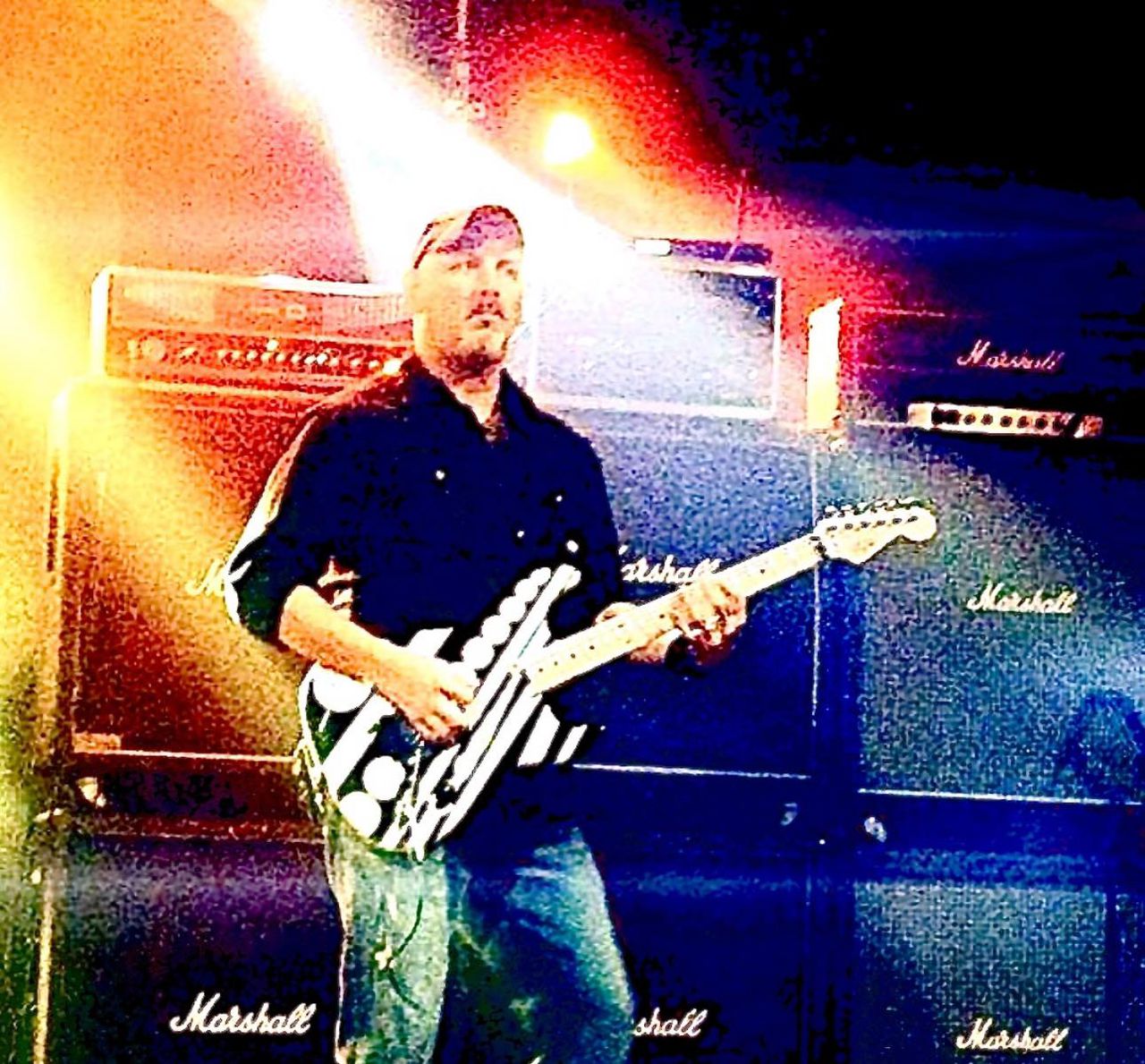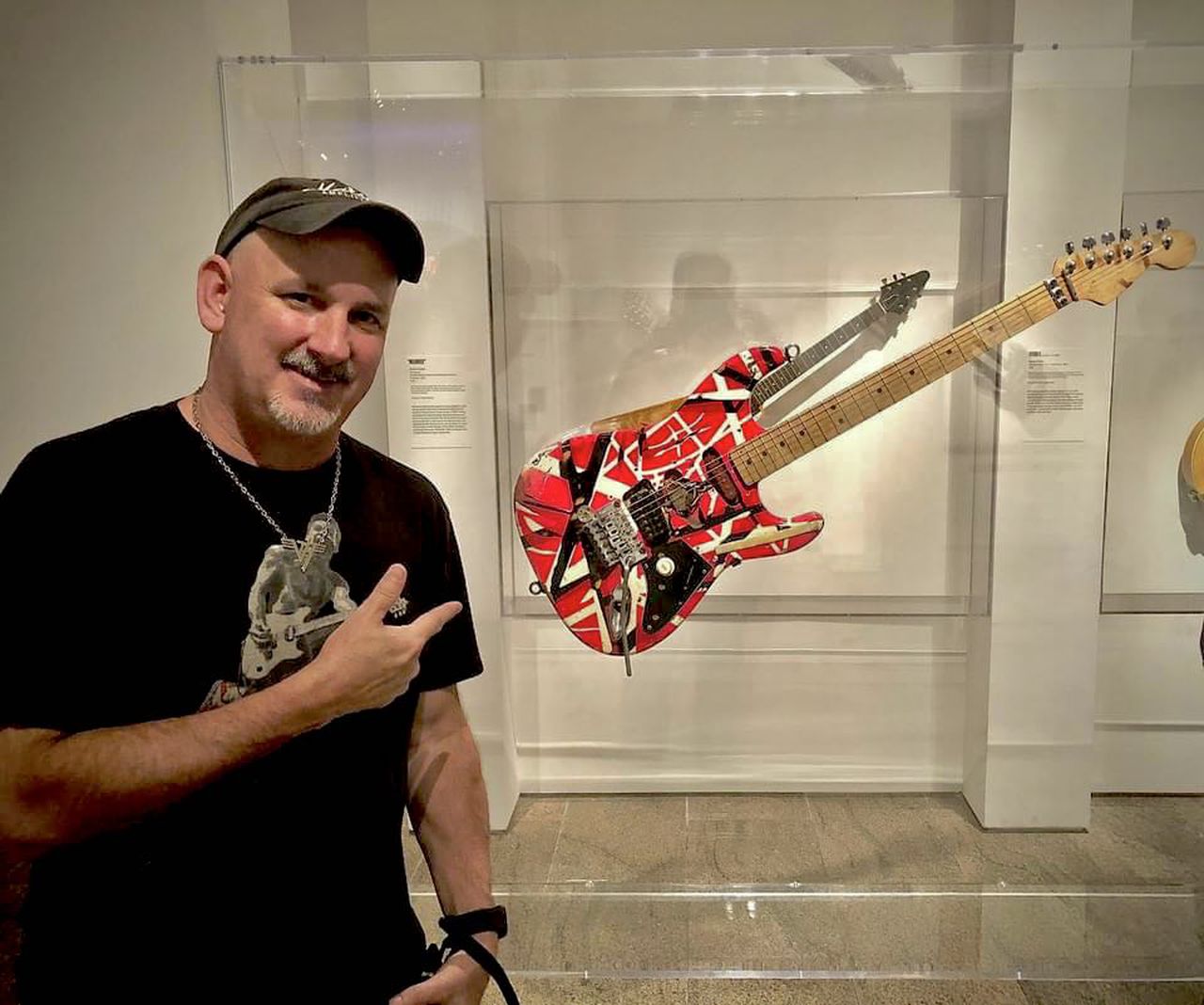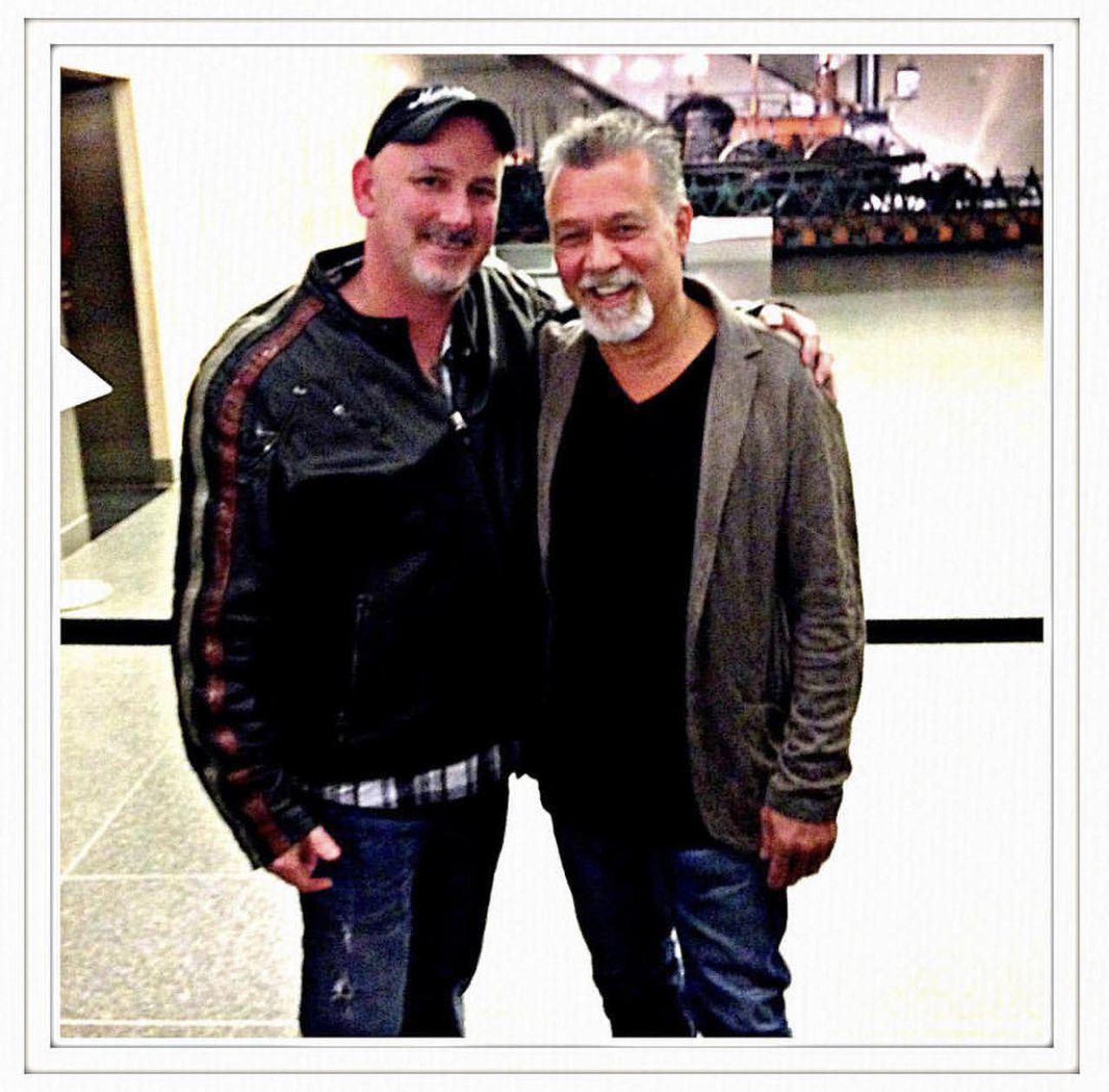How an Alabama musician is helping keep Van Halen history alive
Eddie Van Halen’s right hand reinvented electric guitar, and Jeff Goebel shook that hand twice. Once, as a starstruck fan in Goebel’s early 20s. The second time, decades later after Van Halen was honored for a life of musical excellence and innovation, at Washington’s Smithsonian National Museum of American History in 2015.
As he shook Eddie’s hand – the same hand that finger-tapped the quintessential rock guitar solo “Eruption” — at the Smithsonian during a meet-and-greet after the event, Goebel thanked Eddie for his music. “And then I told him I’d been waiting 30 years to tell him that,” Goebel recalls.
In return, Goebel got one of those beautiful Eddie smiles, seen onstage thousands of times at concerts by Eddie’s namesake band Van Halen’s concerts and millions of times in music videos like “Jump,” Van Halen’s number-one hit from 1984.
Alabama musician and Van Halen superfan Jeff Goebel, left, with rock music legend Eddie Van Halen. (Courtesy Jeff Goebel)
The band Van Halen ended on October 5, 2020, after Eddie died at age 65 after years of fighting cancer. But the music Van Halen made – as heard on songs ranging from hard-edged early classics like “Runnin’ with the Devil” to later pop-friendly hits like “Dreams” – is as alive as ever. And always will as long as electric guitars and fun exist.
Van Halen sold more than 75 million albums worldwide. But since the band often let their recordings and concerts do most of the talking, particularly in later years, there are still slivers of their story yet to be told. There’ve been some excellent books about the band, including author Greg Renoff’s essential “Van Halen Rising” on their formative years. But there’s no official biography or documentary.
So, there’s a thirst for content like Goebel’s video podcast series “Van Halen Stories,” launched about a year and half ago. Now 30 episodes in, Goebel has interviewed the likes of Van Halen insiders, like amplifier guru Dave Friedman, guitarist Damon Johnson, whose Southern rock band Brother Cane toured with Van Halen in the ‘90s, and photographer Neil Zlozower, who captured many classic VH images.
Other interviewees have included the likes of journalist Jas O’Brecht, who conducted the first major Eddie Van Halen interview, and Great White guitarist Mark Kendall, who grew up watching Van Halen nascent shows in the band’s Southern California stomping grounds.
Asked for his favorite eps so far, Goebel cites the Johnson chat. “Because I knew Damon since back when he would come into the music store I worked at and play ‘Hot for Teacher,’” he says. “And he’s a fantastic storyteller.”
The Friedman episode was also special for him, as Friedman worked on Eddie’s legendary Marshall amplifiers used on countless crucial Van Halen recordings. Goebel likens his Van Halen passion project to archaeology. “It’s about getting into the cracks and bringing out stuff people will really enjoy.”
On the podcasts, Goebel is a sharp and knowledgeable interviewer. He’s been a huge Van Halen fan since he first saw the band as a teenager on a late-night TV broadcast of their live video for the song “Unchained,” off fan-favorite 1981 album “Fair Warning.” Goebel says, ”It was like an electric shock went through me.”
In addition to Eddie’s nimble chops, Goebel says, “what came across how much fun Eddie was having. He was always smiling.” He became further entranced after attending a Birmingham show on Van Halen’s tour supporting their mega-selling “1984″ album, which boasted songs like “Panama.”
Recently, Goebel became a contributor to Van Halen News Desk, the band’s unofficial mouthpiece. Run by Jeff Hausman, a lifelong Van Halen fan, VHND, or “Desk” in fan-speak, has been the go-to online news source for updates on the band since the mid ‘90s.
Before that, Hausman, a Nebraska native and longtime Phoenix resident, ran “The Inside,” Van Halen’s latter-day official print publication. Over the years, Hausman, who also operates an official online Van Halen merch store, interviewed every member of Van Halen, including classic era frontman David Lee Roth, latter day singer Sammy Hagar, drummer and Eddie’s brother Alex Van Halen, classic era bassist Michael Anthony and latter-day bassist Wolfgang Van Halen, Eddie’s son.
Hausman had featured many of Goebel’s podcasts on VHND. They became Facebook friends, and eventually met in person at the 2015 Smithsonian event.
“I noticed he was as creating some good content by himself,” Hausman says of bringing Goebel into the VHND fold, “and I talked to him on Facebook a couple of times. I just thought I’d reach out and ask him if he wanted to join the staff, and then it would be easier to feature his content more often.”
Goebel is the perfect guy for the Van Halen News Desk gig. In addition to being a lifelong fan, he’s an accomplished guitarist and full-time musician who performs around 200 gigs a year with multiple bands, including his Huntsville-based Van Halen tribute act “Forever Unchained.” He owns several reproductions of Eddie Van Halen’s famous self-built guitars.

Huntsville, Alabama-based musician and Van Halen superfan Jeff Goebel. (Courtesy Jeff Goebel)
When Hausman reached out to Goebel, it was a huge honor, Goebel says. “I love the Desk and have been a big fan my whole life,” going back to the website’s print predecessor “The Inside.”
Goebel’s VHND content has included recent pieces on Nuno Bettencourt, guitarist with the band Extreme and a torchbearer of Eddie’s blistering/melodic soloing style, and Metallica guitarist Kirk Hammett’s memories of seeing Van Halen live on the band’s first national tour opening for metal lords Black Sabbath in 1978.
Hausman fell in love with Van Halen’s music as a teenager growing up in Omaha, Nebraska. He first heard the band’s recordings, including the game-changing self-titled ‘78 debut album, on portable cassette players friends brought to school.
In addition to the albums, Hausman began collecting T-shirts emblazoned with Van Halen’s famous winged VH logo. No easy feat, as unlike many big rock groups, Van Halen didn’t have a mail-in catalog back then.
Now 54, Hausman first saw the band in concert during Van Halen’s tour supporting their 1986 “5150″ LP, their first album after Hagar replaced Roth after an acrimonious split.
Hausmann likens Van Halen to “America’s Led Zeppelin,” adding, “They’ve always been arguably the greatest American band and they’re one of the best bands in the world. But I’ve always thought they were the most underrated band ever, even with them selling millions of albums.” Part of this is because Roth, known for his ultra-dude charisma and frontman prowess, is a chronically underrated lyricist. “If Dave had died in in an airplane crash in the ‘80s, he’d be like Jim Morrison,” Hausman says.
Van Halen News Desk’s staff numbers around seven or so. As well as breaking news, the Desk is also a source for debunking frequent rumors regarding the band. Even in these post-Eddie years, tribute concert hearsay and other stuff gets floated, especially after Wolfgang Van Halen’s jaw-dropping performance of Van Halen classics at 2022 concerts honoring late Foo Fighters drummer Taylor Hawkins, a massive VH fan.
Most recently, Van Halen set the internet ablaze when unreleased “holy grail” video footage of the band’s Monsters of Rock festival set from 1984 in England surfaced.
In that footage, Van Halen’s mix of musicality, songcraft, sex appeal, sense of humor, and onstage power was on vivid display. The band is shown tearing through a daytime set and unfamiliar stage and production. As the band hit those curveballs, you could see Roth, Eddie, Alex and Anthony drawing on dues they’d paid in the ‘70s playing Pasadena backyard parties and Hollywood rock clubs.
The ‘84 Monsters of Rock footage has been taken down due to trademark/copyright stuff. But Goebel says the footage displayed what makes the band so enduring. “They had such different tastes, which was also their Achilles heel.” Roth loved R&B, while the Van Halen brothers loved hard-rock like Cream and Led Zeppelin. Anthony added tasteful basslines, and glass-shattering backing vocals that complimented Roth’s hairy-chested bellow.
Asked for his dream guest for his “Van Halen Stories” podcast, Goebel says, “I’d love to have [Eddie Van Halen’s ex-wife and the actress/author] Valerie Bertinelli on, because I want to know more about who he was as a person.”
The numbers 5150 are familiar to many Van Halen fans. In addition to being the title of the band’s first album of their Hagar era, it’s also the name of Eddie’s legendary home studio. (The guitarist copped the numbers 5150 from California police code for a mentally disturbed person.)
Goebel is a VH fan of the higher order, though — the kind that also knows the number 1881′s significance. That’s the address of the humble Las Lunas Street home in Pasadena the Van Halen family lived in, after immigrating from the Netherlands, when Eddie and Alex were young children.
The family spoke little to no English when they arrived in the U.S. and with next to nothing for possessions. Legend has it, with just a suitcase, 50 bucks and an old piano.
Eddie and Alex Van Halen’s ascension from those hardscrabble roots to rock superstardom is an all-time American immigrant success story. Goebel has traveled to California to visit the 1881 Las Lunas St. home — which Eddie continued to live in through Van Halen’s early days when not on tour — three times.
It’s always a stirring experience for Goebel to stand before the house where a young Eddie Van Halen sat on the edge of his bed and practiced guitar all night for years and years. Sharpening talent and technique that would eventually make him the greatest rock guitarist who ever lived.
“On that street,” Goebel says of 1881 Las Lunas, which is roughly 900-square-feet in size, “it’s probably the smallest home.”

Alabama-based musician and Van Halen super fan Jeff Goebel is shown in front of Eddie Van Halen’s famous “Frankenstein” guitar, which was displayed in a Metropolitan Museum of Art exhibit featuring famous guitars. (Courtesy Jeff Goebel)
Eddie’s playing has been being hugely influential on later rock stars like Slash, Jack White, Tom Morello and Kirk Hammett. He was also an innovator as a guitar builder. He custom-built his now iconic Frankenstein guitar, mixing Gibson and Fender parts and idiosyncratic tweaks to achieve the sound he wanted. He also applied the axe’s signature striped red, black and white paint-job. On the garage walls at 1881 Las Lunas St., black and red overspray remains visible to this day.
It’s quite the arc, going from Las Lunas Street to the Smithsonian. While Goebel was at that 2015 Smithsonian event honoring Eddie, “I just kept thinking this is like getting to meet an [Thomas] Edison or some other inventor like that. That same kind of level of influence.”
MORE ON MUSIC:
The greatest Huntsville concert that never happened
Wolfgang Van Halen talks Mammoth WVH, Guns N’ Roses tour, Van Halen
Ann Wilson talks Heart, new Muscle Shoals album, Led Zeppelin
Zakk Wylde talks Black Label Society, Ozzy Osbourne
Guitar hero Tracii Guns talks L.A. Guns, Axl Rose, Izzy Stradlin
‘80s glam-metal survivor Taime Downe of Faster Pussycat tells all
